BEAST FROM THE EAST RETURNS
A chilling blast
by TurfPro Editor, Laurence Gale MSC, MBPR
Turf professionals have been facing challenging conditions lately, but have found plenty of jobs to keep them occupied - including attending the Amenity Forum Updating Events online.
Before I get into it today, I’d just like to draw your attention to a new feature we have kicking off this issue.
From today we are delighted to bring you regular articles focusing on turf professionals working in the Republic of Ireland written by our incredibly knowledgeable Ireland editor, Alan Mahon. Many of you might know Alan from his years editing the magazine for the Irish greenkeeping association, the GCSAI. In more recent times he is the editor of one of our sister titles, Service Dealer Ireland.
Alan will be bringing us in-depth stories of the professional turf care scene across the Irish sea every on a regular basis, giving us insight into how our Irish colleagues are facing up to the common challenges which we are all facing.
Speaking of which, the weather and the pandemic continue to be in the news! Storm Darcy has delivered a bitterly cold weather front across most parts of the country, with some areas receiving up to 200mm of snow, with snow drifts being formed by high winds. This current cold spell will no doubt affect and prevent a number of grounds activities being undertaken.

However, there are plenty of other jobs that can be undertaken. I notice a lot of golf courses are carrying out tree maintenance work, making good use of the down time from general maintenance duties. Felling, crown lifting and thinning of tree plantations is a good job to be undertaken - also an excuse to have a good bonfire and keep warm during this cold spell.
Last week I enjoyed watching the start of the annual Six Nations Rugby Tournament, with Scotland , Wales and France winning their first round of matches. All three stadiums’ pitches performed well. Jim Buttar, head groundsman at Twickenham, along with staff Ian and Andy, had particularly worked miracles, having only just resown the pitch back in December.
It is a credit to their skills, dedication and the use of modern pitch renovation techniques that now allow stadium grounds professionals to produce a playable pitch within 8-12 weeks.
The pandemic is still very much in the news, with lockdown continuing and travel restrictions in place. I, like many of us, am looking forward to the date when we can get back to some sort of normality where we are able to meet fellow professionals and start seeing sport being played again, particularly at grass roots levels.
Amenity Forum Updating Events
On 9th February I, along with sixty plus industry amenity professionals, attended one of the first free Updating Events. A Zoom-style meeting, it was designed for all involved with, or with an interest in, amenity management.

In his brief introduction, the ever-present Professor John Moverley, said, “For everyone engaged in amenity management, these are really important times. The pandemic and all its consequences will have a long-lasting impact on everyone - and those engaged in managing amenity spaces are certainly not exempt from this. What has been demonstrated is the essential nature of much of the work we undertake - especially in seeking to keep parks, transports networks, sports surfaces etc. safe and healthy and fit for purpose. However, nobody can predict with certainty the future. With an economy under real stress and unemployment up, there will be fewer resources available and certainly changes in patterns of use of amenity spaces”.
Challenging times for us all. We soon got down to business with presentations by Keith Dixon from the Health & Safety Executive (HSE), who gave an update on matters concerning the legislation around pesticide usage in the UK.

2021 has seen the UK fully depart from the EU, bringing with it new regulations on plant protection products. The UK is also issuing a new national action plan relating to amenity management in 2021. Just these two items present challenges and opportunities to overcome in the coming months.
John Moverley then addressed the meeting stating the importance of the roll the Amenity Forum plays in terms of setting up and addressing the Amenity Standards required to comply with government legislation when it comes to the handling, storing and the use of pesticides in the amenity sector. He was also keen to mention a very important survey being undertaken by government (delivered by Fera Science Ltd) to gain information on the amount of pesticides used, the different types and categories and also a little additional information on numbers of sprayers, qualified staff etc. It is vitally important that the sector fully supports this work as it will form the basis for future policy, strategic decisions and it will provide valuable information for use across the sector. The survey can be completed here.
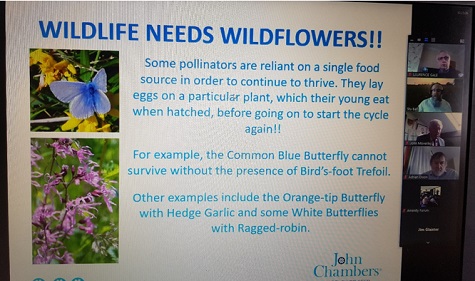
Next up was Stuart Ball from John Chambers Wildflowers who gave a talk on the popularity of wildflower mixes in recent years and the importance they bring to help create and improve the diversity of our landscape and provide valuable food source and habitats for insects. There are now a wide range of wildflower / flora mixes now available in both seed, plug and carpeted form to help establish new plantings.
We then had a breakout session to discuss some industry issues that were fed back to the Amenity Forum team which largely stated we need to be better at communicating the professionalism of our industry.
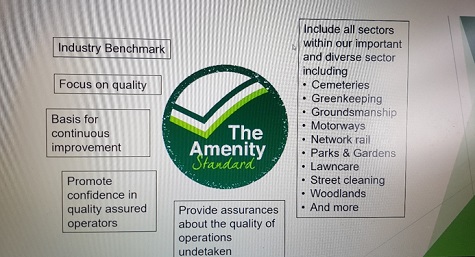
This point was reiterated by John Moverley as part of his closing speech. ‘’The important and essential nature of amenity management may be something those engaged in it understand but we must ensure that message is articulated clearly and strongly to all, especially the public and policy makers. Everyone involved should be immensely proud of what they do but now is the time to say it loud. There may be critical times ahead, but working together the sector can face such times and be successful, of that I have no doubt’’.
The National Action Plan will be the key focus at a series of free Updating Events being held by the Amenity Forum over the coming weeks. They are half day long, free, open to all and are run entirely online. It is really important that those engaged in, or with an interest in, amenity management are fully aware of the potential changes and express their views. These free events will provide this. For details of registration, please contact Kate at Admin@amenityforum.net. The remaining dates available are February 23rd, 25th and March 4th.
Grassroots concerns
Finally my last piece of news relates to a news story about the concerns of David James seen in The Guardian that Grassroots football clubs have lost 48% of their income since the Covid-19 pandemic struck. The former England goalkeeper warns “we are going to lose a generation of football participants” if something is not done.
Another report suggests that more than 5,000 grassroots football clubs will cease to exist as a result of the COVID-19 pandemic. The study, entitled The Final Whistle For Grassroots Football, found that 96% of clubs in the UK have seen a reduction in income in the last year.
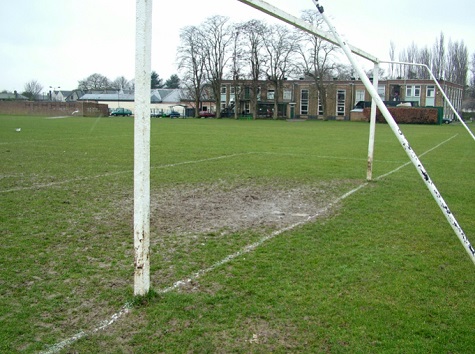
I totally agree with these reports. Grass roots sports across the board - football, rugby, tennis, cricket and bowls - all face a similar scenario. With no competitive sport being played, no regular use of the facilities will have dramatically affected clubs’ incomes. To add to the woe, many youngsters will have no doubt found other pastimes to keep them amused and occupied during the pandemic. The unknown question will be how many of them will bother to return, or indeed will be lost to the sport for good?
We will not know the true effect of this pandemic until 2022. I personally would agree we could lose up to 12% of these clubs. These grass roots clubs are essentially hubs of the community and we need the government to recognise the importance of them and support a programme of investment once this pandemic is over to ensure they can remain active and viable for the next generation of youngsters.
 |
|
 |  |
TORO ACQUIRES AUTONOMOUS COMMERICAL MOWER DEVELOPER
Turflynx of Portugal
The first WEB ONLY story this week is The Toro Company has announced that it acquired Turflynx, a privately held developer of autonomous mowing equipment for golf courses.
ICL SPONSOR AMENITY FORUM ONLINE EVENT
Taking place on 25 February 2021
The next WEB ONLY story is ICL has announced that it is sponsoring the upcoming Amenity Forum ‘Meeting the Challenge’ online event.
LONDON STADIUM INCREASES FLEET
More Dennis cylinder mowers
Head groundsman at the London Stadium, James Williams, explains why Premier League rule changes led to an increased fleet of G860s.
The London Stadium has recently increased its fleet of Dennis G860 cylinder mowers.

Head groundsman James Williams is about to embark on his fourth year in the role and understandably, he believes that 2020 has been the most challenging yet.
“It’s been a difficult year due to the pandemic,” he said. “The worst thing is waking up in the morning on a matchday and there’s just no spark because you know there will be no fans to showcase your pitch to.”
James takes great pride in his work; he is hard-working, committed and works round the clock to ensure that the pitch is in the best possible condition. Anywhere he can make improvements he will strive to do so - and therefore when an opportunity presented itself, James was quick to seize it.
“When football started again, the Premier League announced that we have to prepare the pitch and leave it well alone five hours before kick-off - it used to be three,” said James.
“This would mean starting a lot earlier and so my CEO asked me if there was anything I needed which could help. Straight away, I told him that two more Dennis G860’s would be nice!”
The London Stadium already had three Dennis G860’s when James arrived, and he was pleased to see a familiar mower - one which he had become accustomed to for many years previously.
“I used the G860’s the whole time I was at Swansea City FC,” he said. “I’m just extremely comfortable with them - they are reliable, adaptable and they get the job done to the high standard I expect.”
James continued, “The G860’s are normally brought out towards the end of the week once the pitch has been repaired to make sure that it is in the best shape going into a matchday.
“When the grass gets too thick, or if it’s dying off, we will use the verticutting cassette to clear that out – just to stop it from causing any thatch or disease. We probably verticut once a month as well as use the brush – both help to keep the pitch nice and healthy.
“The 8 bladed cutting cylinder always offers a fantastic finish,” continued James. “I like to cut down to 23mm for matchdays but if there is period when we’ve got a lot of games and training sessions on the pitch then I’ll take it up to 26mm for extra protection and coverage.
“Do you know what I like about the G860?," concluded James. "It’s the fact that it hasn’t changed a lot. Dennis as a company has evolved with some other great machinery but the G860 doesn’t need to. Why would you evolve something that doesn’t need fixing? You can’t improve perfection.”
 |  |
JOHN DEERE & WIEDENMANN ENTER INTO AGREEMENT
But not in the UK and Europe
John Deere commercial turfcare dealers in Region 4 can now sell and support Wiedenmann aeration products.
John Deere commercial turfcare dealers in Region 4 can now sell and support Wiedenmann aeration products following an agreement that covers the U.S, Canada, Australia and New Zealand.
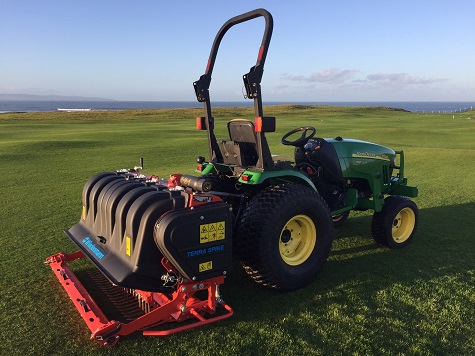
Manny Gan, director, global golf sales & marketing, John Deere said through the agreement, which does not apply to the UK and Europe, the company was ".providing customers with streamlined access to the industry’s top solutions through their John Deere dealer.”
Uwe Wiedenmann, managing partner, Wiedenmann Corporation, added, “John Deere has a reputation for delivering quality products and providing outstanding service, aligning with the Wiedenmann values and making this relationship a natural fit. Through this agreement, we’re offering our aeration solutions to a wider range of customers, in addition to our existing distribution and dealer network, making it easier for them to acquire the products they need."
FRASER C ROBB TAKES ON FOAMSTREAM
Exclusive Scottish sales agreement
Drymen-based Fraser C Robb has been awarded exclusive sales rights in Scotland to sell Foamsteam, herbicide-free weed killing equipment.
Drymen-based groundcare and garden equipment supplier Fraser C Robb has been awarded exclusive sales rights in Scotland to sell Foamsteam, herbicide-free weed killing equipment.
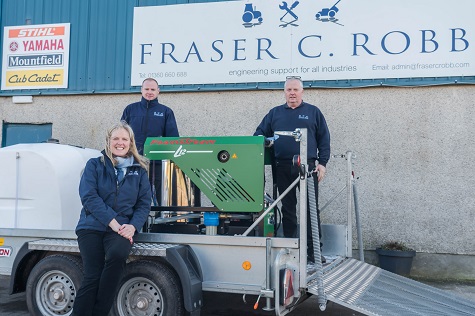
Pictured front, Lorna Robb (director); back left Gary Cowan (commerical sales manager); and back right Struan Robb (director)
The system has been developed by Weedingtech, who have successfully launched this product in markets around the world. This deal will for the first time provides customers in Scotland with access to an environmentally friendly solution for clearing weeds.
The Foamstream herbicide-free system combines heat and water, with a foam solution that is described by the company as both safe and highly effective. As well as removing weeds, it can with special lances remove gum, graffiti and clean street furniture.
The company also envision that Foamstream could help reduce the transmission of Covid 19 virus, due to the high temperatures used in application.
Fraser C Robb director Lorna Robb said, “Our business is within a National Park and we know from our customers throughout Scotland the sensitivity to our land, waterways and public areas, Foamstream will allow them to kill weeds in a way completely safe to the environment. This system will also be more effective in keeping our towns and cities clean, saving organisations time and money.
"We are delighted to be bringing this product to market in Scotland and working with the innovative team at Weedingtech. We have seen the impact of it being introduced in other markets and know that this product will be revolutionary to the operation of councils, land estates, sporting facilities etc. throughout Scotland. This is an excellent addition to our growing range of environmentally friendly garden and ground care equipment”.
Aaron Matthews, UK & ROI sales manager at Weedingtech said, “After many conversations with prospects in Scotland, Fraser C. Robb were the natural choice to be our distribution partner due to their fantastic reputation among their customer base and the instant enthusiasm they had for the product."
 |  |
FIFA'S GREENEST FOOTBALL CLUB MAKE SEED SWITCH
Change at Forest Green Rovers
The club is now using Johnsons Sports Seed programme in the fight against weed ingress and disease on their main pitch as well as their training ground.
It isn’t just grounds manager Nigel Harvey who has moved from the Stanley Park Training Ground to the main Stadium pitch of Forest Green Rovers FC - his Johnsons Sports Seed programme has made the switch too.
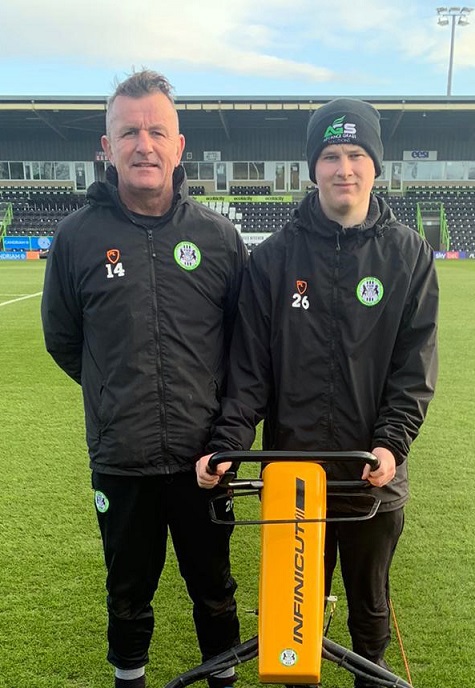
Having used Johnsons mixtures for 15 years, the club’s renowned eco and environmentally friendly approach means the combination of J Premier Pitch and J 4Turf will become Nigel’s main weapon in the fight against weed ingress and disease.
Nigel moved from Forest Green’s training facility to take up his new position at The New Lawn Ground in June 2020, which he maintains alongside a recently appointed apprentice.
“The maintenance methods are very different between the training ground and the stadium, with fewer conventional tools and techniques at my disposal in the approach we take to issues such as weed and disease control,” he explains. After being described by FIFA as ‘the greenest football club in the world’ and becoming the first UN certified carbon-neutral football club, it’s out with chemicals and in with cultural practices - including regular overseeding.

“Johnsons J Premier Pitch has proven itself to deliver fantastic resistance to disease, great appearance and plant strength at our training ground, so achieving that is going to be key moving forwards in maintaining surface quality and health at the stadium.”
One of Nigel’s first projects was a major drainage installation programme, the recovery from which saw 20 bags of J Premier Pitch oversown on The New Lawn pitch. “It’s first usage at the stadium and it germinated in 6 or 7 days and we conducted the first cut at just over 2 weeks – it was fantastic.
“We will then compliment the J Premier Pitch with Johnsons J 4Turf mixture, with tetraploid perennial rye which works well for winter overseeding. This will help to give us some additional strength in high wear areas such as the goal mouths as well as give us a fighting chance to repair any damage or bare patches through the cooler months.”
Nigel concludes, “From previous experience, I trust that Johnsons will put us in the best possible position in terms of retaining all-important coverage and plant strength to help resist weed ingress and cope with disease pressure as and when it returns.”
 |
|
 |  |
ADVERTISE YOUR JOBS HERE
Amazing success rates!
Advertise your recruitment needs on TurfPro Weekly Briefing and reach our targeted audience of recipients every week.
Contact Nikki Harrison for details - 01491 837117
|
 |  |
EDITOR'S BLOG ARCHIVE
Catch up with Laurence Gale's recent blogs
Want to catch up with one of editor Laurence Gale's blogs? Here is the place to do so.
TURFPRO FEATURE ARCHIVE
Find our previous features here
If you want to catch up with any of TurfPro's previous features, here is the place to do so.
GREEN SPACES DO NOT LOOK AFTER THEMSELVES!
Keith Kent says we must invest in people
WE SHOULD TELL THE WORLD ABOUT THE UK INDUSTRY
Right time for all sides to come together
SOIL LIFE IS PRECIOUS
Good-quality soil can help save the planet
MORE THAN JUST CUTTING GRASS
Encouraging the next generation
A BUZZ FROM DOING THE JOB
Wide experience of the turf grass industry
PAYING THEIR WAY
Low wages is the bane of the industry
AMENITY MANAGEMENT IMPACTS US ALL
Professor John Moverley
CARING FOR PARKS OF ALL TYPES
Mary Worrall
TOP FIVE FRUSTRATIONS FOR CRICKET GROUNDSMEN
What causes you the most frustration in your role?
PROFESSIONALS AT THE CUTTING EDGE
Vic Demain and Phil Sharples
BOWLS CLUBS IN PERIL
A sad decline
A VERY SPECIAL INDUSTRY
Loz looks back
SNEAK PEAK AT A ROBOTIC "GAME CHANGER"
Commercial model capable of covering 50,000 m2 teased
HALESOWEN PICK A BIG ROBOT UP FRONT
Invest in mowers
COMPRESSED AERATION
The new way
PARKS MATTER MORE THAN EVER
Recent sector developments
ON TEST
STIHL blowers
THREE CORE VALUES TO SHAPE OUR INDUSTRY
Real concerns for the future
ENGLAND'S GREEN SPACE GAP
A split along racial lines
ON TEST
EGO STX3800 strimmer with RTX2300 Rotocut head
A SECTOR FACING IMPORTANT TIMES
Review of the National Action Plan
PARKS MATTER
The role of public parks in the recovery: a discussion paper
A UNIQUE SPORTING VENUE
Wormsley private estate
A BTME OUTDOORS?
A good bet for the industry
PARKS NEED APPROPRIATE POLITICAL REPRESENTATION
Q&A with Philippa Reece, Parks and Foreshore Manager at Adur and Worthing Council
CRICKET LOAM
What does it mean?
A HERCULEAN EFFORT TO GET PARKS BACK TO NORMAL
Q&A with Chris Worman, Rugby Borough Council’s parks and ground manager
ON TEST
STIHL battery products
TURFGRASS STRESS MANAGEMENT
Reactive Oxygen Species (ROS) and antioxidants during biotic and abiotic stress in turfgrass plants
AUTUMN DISEASE MANAGEMENT
The coming months are going to prove very difficult
THE ABUSE OF PARKS . .
Is the abuse of society
WHY PARKS MATTER?
A statement from the Parks Management Forum to the Prime Minister
THE 21st CENTURY PARKS MANAGER
Innovative, creative and entrepreneurial
EAT, SLEEP, CUT, REPEAT!
Cricket under covid
TIME FOR A SINGLE SHOW?
Debate brought back into focus
A CHALLENGING TWO MONTHS
Running golf design projects from home
PRESSURE SITUATION
Cementing the reputation
A CLUB TO BE PROUD OF
10 years at the helm of Olton GC
GAME CHANGERS IN TURFCARE
The day the Lord's outfield reconstruction proved its worth
THE ESSENCE OF ESSENTIAL
Finding a sensible way forward on defining "essential maintenance"
THAT WAS THE YEAR THAT WAS
2001
HOW TO LOOK AFTER A GOLF COURSE WITH NO GOLFERS
Fundamental to the survival of almost all courses, if not of the game itself
RAIN STOPPED PLAY WOULD BE WELCOME
. . along with ‘lunch is being taken early’
PHYSICAL CONTROL OF TURFGRASS PESTS
An urgent problem
A DIVERSE & ENTERTAINING WEEK
Successful BTME 2020
INTEGRATED PEST CONTROL
Opportunity to embrace new methods
ENVILLE ON THE UP
Major investments taking place
GREEN FLAG AWARDS 2019
A great success
U.S PROFESSIONAL EQUIPMENT SHOW EXCELS
Buoyant GIE+EXPO
LEGACY OF THE SOLHEIM CUP
At Gleneagles
A DAY OUT WITH THE LADIES
Behind the scenes at the Solheim Cup
COVENTRY UNIVERSITY'S EDIBLE GARDEN SUCCESS
2006 - present
HAIL THE GRASS MASTERS!
Boorish media comments about pitch quality are wide of the mark
CONTRACTOR SEES MULTI-DISCIPLINE SUCCESS
360 Ground Care serving professional facilities
BUSY TIMES
Judging the Green Flag Awards
TAKING AN INTEGRATED APPROACH
What does it all mean in managing turf surfaces?
UNDER PRESSURE
Dry weather conditions continue to keep turf managers focused on moisture management
EDDIE SEAWARD
Death of Wimbledon’s influential grounds manager
MAJOR NEW IRRIGATION PROJECT
At Top 100 classic Berkhamsted Golf Club
NEW HORIZONS FOR THE HATTERS
Investment paying off at Kenilworth Road
ELIZABETHAN RESTORATION
At Castle Bromwich Hall Gardens
WHAT IS BIOPHILIA?
The vital impact of parks and green spaces on health and well-being
WORM CONTROL
Without carbendazim
THE TRUE COST OF PETROL
Battery-powered outdoor power tools are now turning the heads of professionals
SANDS OF TIME
Sand-based pitches are now the norm in professional sports
WHY DO WE DO THE RIGHT THING?
We must maintain industry standards
CHASING GRASS PERFECTION?
11 things you need to know . . .
MAINTAINING STANDARDS
Q&A with BASIS ceo, Stephen Jacobs
STRI RESEARCH DAY 2018
Hosted at research trial grounds in Bingley
THE MECHANIC
Leicester City FC invest in new role
LORD'S 'GRASS-GUVNOR' TO RETIRE
Mick Hunt bows out after 49 years
HOLLOW CORING & DEEP SCARIFICATION
Is it really necessary?
 |
|
 |  |
 |  |
 |  |
 |  |
FROM ACROSS THE IRISH SEA
|
A SHINING LIGHT IN IRELAND'S SUNNY SOUTHEAST
Wexford Golf Club
by Alan Mahon, TurfPro's Ireland editor
In the first of a new series, TurfPro's Ireland editor Alan Mahon says that founded in 1961 as a 9 hole course, Wexford Golf Club has matured into a wonderful 18 hole parkland course situated in the heart of Wexford town.
Founded in 1961 as a 9 hole course, Wexford Golf Club has matured into a wonderful 18 hole parkland course situated in the heart of Wexford town. The course, which was lengthened and upgraded in 2006, is a par 71 course, measuring 6,545 yards from the championship tees and provides a challenge for players of all standards.
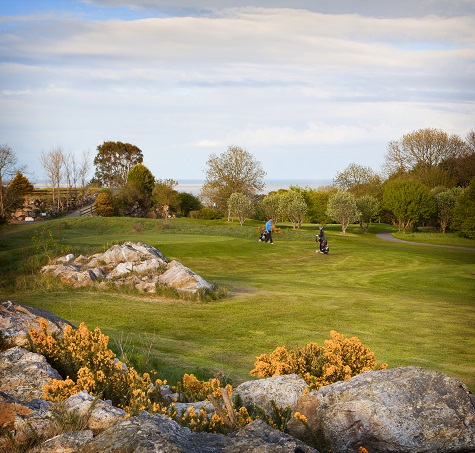
The 4th tee surrounded by quartz rock formations
The location of the club, on top of Mulgannon Hill, affords the visitor spectacular views in all directions. To the north are the Blackstairs Mountains and Wexford Town, while the new holes on the southern slopes overlook Wexford Harbour and most of south County Wexford. The site is close to what locals describe as ‘The Rocks’, an outcrop of quartz, which indicates the type of terrain the golf course lies on.
2020 has been an extraordinary year, to say the least, for the club. With the various Covid-19 restrictions in place, the course was forced to close for a total of 11 weeks. At the time of writing the course has remained closed since the 24th of December. It will be at least the 5th of March before it will be open for play again. Yet, despite being closed, membership has remained steady. However, green fee income has fallen but when play will resume again it is hoped that there will be a big demand for green fees as people relish being able to play outdoor sports and meeting up with one another again.

The view of Wexford town from the 15th hole
Meet the course superintendent
County Wexford native, John Doyle, has been the course superintendent since 2005. Before he came to the Wexford town club John was the assistant greenkeeper in Delgany Golf Club in County Wicklow. His brother, Des, is the course superintendent at Tramore Golf Club in County Waterford.
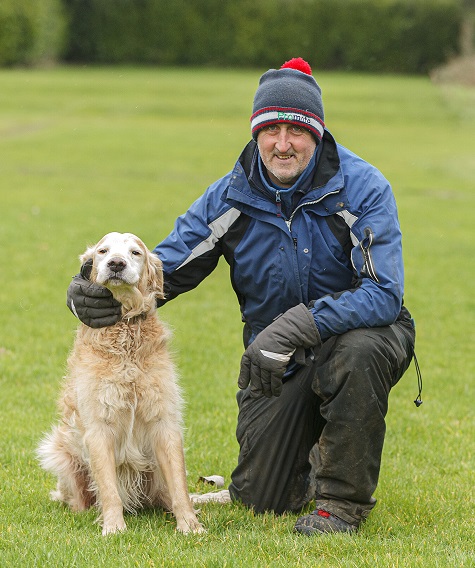
John Doyle with his Golden Retriever ‘Neville’
John started his greenkeeping career at New Ross Golf Club (another golf club in County Wexford) where he learned the basic skills from head greenkeeper Seamus Power.
John is highly regarded by the club committee and its members. So much so that the club gave him Honorary Membership several years ago, a nice gesture in showing their appreciation for the work John and his staff are doing. This would be a fitting way for other clubs to show their appreciation to their course superintendent.
John is one of three full time staff at the Wexford club. Two extra seasonal staff are taken on from April to November.
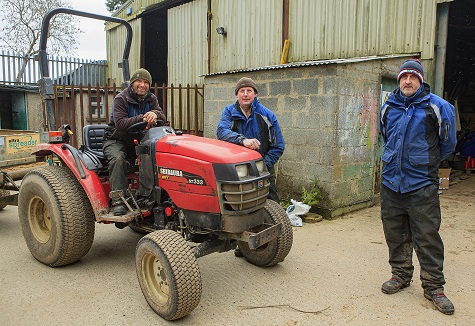
The greenkeeping staff from left: John Kehoe, Joe Cashin and John Doyle
Covid-19
The coronavirus pandemic has affected evryone across the world. It hasn’t escaped Wexford Golf Club either. The lockdown has forced the club to close its gates for members and visitors. Thankfully, turf maintenance on sports pitches and golf clubs is deemed to be essential work. This means that greenkeeping staff can come to work as normal during the lockdown. However, there are some limitations.
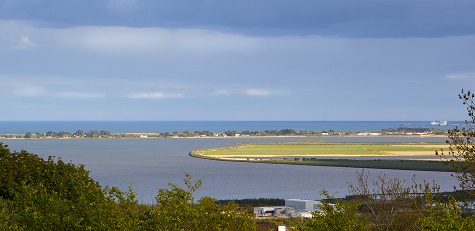
The view from the 13th tee
“In order to reduce contact with each other, we have done away with our morning tea break and shortened our work day by 15 minutes to compensate for it,” said John. “At lunch break we eat seperately. We have to wear our masks when working together, such as doing our bunker lining and remodelling. Having said all that we are extremely fortunate in that the work we do is outdoors so the risk of contacting the disease is significantly reduced.”
Course development
An opportunity arose for Wexford Golf Club to purchase more land, of which they took advantage, and in 2004 work began on constructing five new holes on the newly acquired lands. This was Phase 1 of a three phase expansion project on the course, which also included the construction of 3 new greens on the old course.
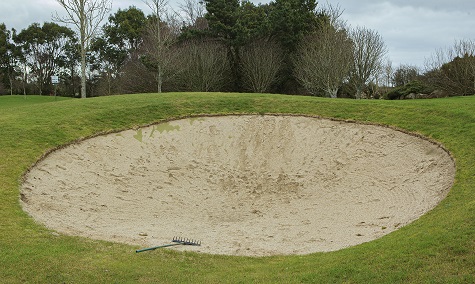
A recently remodelled and lined bunker using astro turf
John arrived to the club just in time to oversee the grow-in of the new holes. Turf from 5 of the greens on the old course was used to sod the newly constructed greens, which meant that 5 temporary greens had to be opened to allow a relatively smooth transition to the new holes. The greenkeeping staff undertook the task of re-sodding these greens themselves.
Phase 2 of the project began in 2006 when 6 holes on the existing course were redesigned. The course now plays longer than the old 18 hole course and, despite this, the par of the course was reduced from 72 to 71. There are now 5 par 3 holes and 4 par 5 holes on the course.
The final phase of the project was the building of the new clubhouse and 2 new greens (1st & 18th). The old 18th green was removed to allow room to expand the car park. The timing of this part of the project was unfortunate as, at the time, Ireland was at the height of the property boom when building costs were at their highest. Two years later saw the collapse of the economy with building costs tumbling, but Wexford Golf Club were already committed to large building cost repayments. Despite this, Wexford can boast of a first class clubhouse, which commands wonderful views of the course, Wexford town and the surrounding countryside.
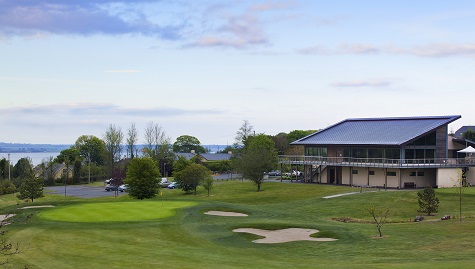
The 18th green and clubhouse
Course maintenance
John’s feeding programme for the greens can vary from season to season. His fertiliser inputs will depend on soil sample results which he gets tested every Spring and Autumn. During December 2020, John was able to hollow core and topdress the greens (using 13mm tines). He applied a 3:0:12 N:P:K feed with phosphites and seaweed (to help build up disease resistance). During hollow coring the greens are overseeded with Crystal Blue Links creeping bentgrass. “This is a new cultivar of creeping bentgrass which is good for low light and shady conditions which should suit conditions here as we have a lot of trees around the course,” says John. The greens are hollow cored in autumn as well.
During the growing season John would usually apply 6 units of Nitrogen as a liquid feed with trace elements added every 14 days.
The fairways are topdressed in May/June and again in September/October. 1500 tonnes of sand is applied during the year.
The greens, approaches and tees have automatic irrigation installed, fed by a newly built 60,000 gallon concrete, above ground, irrigation tank. Water from a nearby well feeds the tank.
In order to obtain his Degree in Turf Management, John did his thesis on the effects of greens rolling using turf irons. His research and trials showed that by regular rolling, the height of the grass could be increased without loss of green speed and that mowing frequency could also be reduced. This had the knock-on effect of fewer disease outbreaks due to the reduced damage to the leaf blade from mowing. John puts this research into practice by carrying out regular rolling using the turf iron.
Environmentally friendly
For several years the rough in the non playing areas of the course have been allowed to grow wild. John Kehoe and Joe Cashin are part of the greenkeeping staff at Wexford and both have a keen interest in wildlife. “We have seen an increase in the butterfly population since we let the grass grow and now the rare Essex Skipper, which arrived 8 years ago, is thriving here,” says John. There is a lot of wildlife activity around the course with sightings of buzzards, sparrow hawks, ravens, badgers, foxes and red squirrels. Woodpeckers have also arrived with a pair nesting on the course.
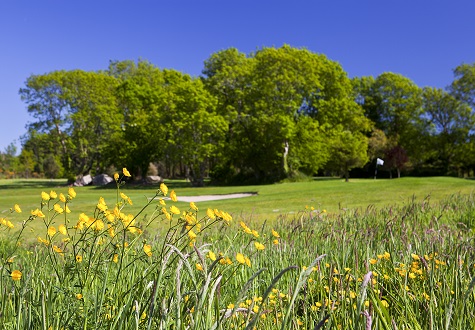
Wild flora thrive in the unmown rough areas. This provides habitat for butterflies such as the rare Essex Skipper
With early morning start times, being a greenkeeper offers the opportunity to see much wildlife in the working environment.
During the winter months, tree planting takes place around the course. Hundreds of native species such as oak, birch, beech, alder, and scotts pine are mixed planted together in groups or spinneys. “We do this to encourage wildlife and it’s also a way of reducing the club’s carbon footprint,” said John. It is truly amazing to see a diverse range of wildlife species thrive at the edge of a major town.
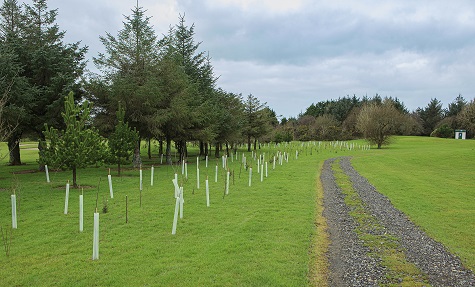
Some newly planted trees
Winter work
Bunker remodelling and lining takes up a lot of the work schedule during winter. John has developed a clever way of upcycling, using old astra turf to line the bunkers. “Over the years we have had problems with bunkers silting up, and water run off after heavy rain would cause clay to mix with the sand. It’s expensive to replace sand in bunkers so I came up with the idea of using old astra turf as a bunker lining,” said John. The astro turf would come from sports pitches around the country that would be replacing their playing surface. The astro turf was free as it would normally be discarded. The only cost involved was transporting it to Wexford. What makes the astro turf suitable for bunker lining is that it prevents soil and weeds coming through but it is also porous, which allows water to drain.
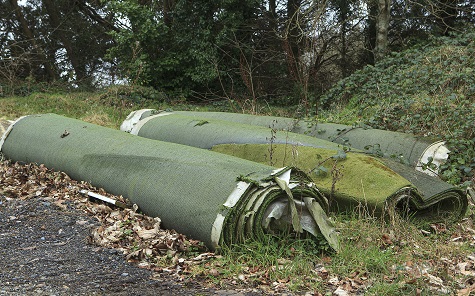
Disgarded astro turf which will be used for bunker lining
Many of the 68 bunkers on the course were designed as very large bunkers and it was getting very expensive to maintain them. The club decided to redesign the bunkers, making many of them smaller. During the remodelling John decided to improve the drainage of the bunkers by adding deep soak holes and filling them with drainage stone. The astro turf would be shaped, cut and fittd in place before the sand would be added.
As mentioned earlier, tree planting is carried out during the winter but some of the more mature trees need to be pruned as well, particularly the lower branches to allow for ease of mowing and for golfers to find lost balls more easily. Many of the smaller branches are shredded as mulch, the bigger limbs being used as firewood.
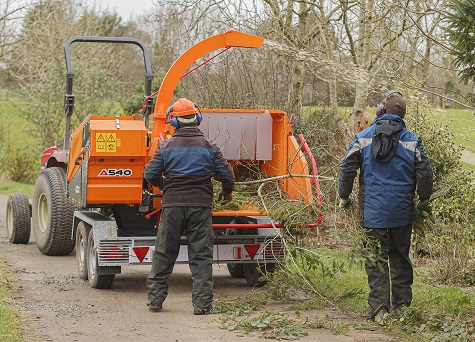
John Kehoe and Joe Cashin shredding branches
Drainage on the course is done in-house during dry periods of the winter. This is done mainly on the fairways and since starting this several years ago, the amount of days closed, due to waterlogging, has decreased significantly. This is helped by regular sanding of the fairways.
Wexford Golf Club has a unique fundraiser to help with course developments such as bunker remodelling. Members have the opportunity to take part in a weekly “Guess where the joker card is” competition in the clubhouse. They have to guess which of the displayed cards contains the joker. There is a small money prize for the winner and all proceeds go specifically towards the course development projects. Some of the members at Wexford volunteer to help out with some of the various projects from time to time.
Wexford Golf Club is a gem of a course. It is hard to imagine, with all the flora and fauna that exists there that you are so close to a busy town. When the club does eventually open for play again, there will be a lot to look forward to for the visiting golfer, all thanks to John and his busy greenkeeping staff.
 |
|
 |  |
GREEN SPACE CONTRIBUTION TO WELLBEING IS UNDERVALUED
Parks invisible on national agenda
by Laurence Gale, TurfPro editor
Next in our regular series of the TurfPro Files, we hear from Bernard Sheridan, Parks Consultant - Interim manager.
TurfPro editor, Laurence Gale writes:
One of the biggest challenges our industry faces in the coming years will be inspiring the next generation of turf professionals to join our sector. We desperately need to start finding ways to encourage more people to come and work in this diverse, international industry.
To help start this process, I have asked a number of our leading professionals to write a piece about how they came to work in this industry and the opportunities it has given them.
Bernard Sheridan, Parks Consultant - Interim manager

Tell us about yourself?
I am a semi-retired old-timer ‘parkie’, currently working as a consultant and interim manager wherever and whenever required, in the green spaces sector.
There are many routes into parks management and mine was by way of the horticulture and sports turf sector.
I started my career in the early 1970s working for Manchester Recreation Dept in Wythenshawe Park firstly on an outside mobile gardening gang, later transferring to the large glasshouse range when it was a fully productive working nursery. I then spent many years working practically in the private sector as a gardener, head gardener and head groundsman. I attained both the RHS Master of Horticulture and the National Diploma in the Science and Practice of Sportsground Management from the Institute of Groundsmanship in my spare time, and I moved from the practical side as Grounds Manager at the Northern Lawn Tennis Club into parks management at Stockport Council in 1990.
I eventually became Head of Environmental Services for Trafford Metropolitan Borough Council, responsible for Parks and Countryside, Grounds Maintenance, Arboriculture, Waste Management, Highways and Street Lighting, Streetscene Services, Warden Services etc.
When I retired, I missed working in parks and green spaces and wanted to give something back, so now work providing advice and management support to local authorities and various organisations, undertaking many assignments across the UK.
I am a Chartered Horticulturist and Member of the Chartered Institute of Horticulture and an Association of Public Service Excellence (APSE) Associate;
I have been a Green Flag Award judge for over 20 years, have recently become an RHS NW in Bloom judge and have had articles published in various magazines relating to current issues in the green spaces sector. I enjoy our garden where I’ve created varied habitats to encourage wildlife, I dabble in bonsai, and, with the family, visited and photographed parks and gardens throughout the UK and the world, including the lively Yoyogi park in Tokyo and the sublime Ryo-Anji garden in Kyoto.
Who or what inspired you to take up your career?
My Dad was a brilliant grower and allotmenteer, but when he died suddenly in my late teens, I wanted to keep his garden up to scratch, so I took up evening horticulture classes at South Manchester College as an enthusiastic novice. The tutors could see I was keen, so suggested I apply for a vacancy with the local park department, which got me started. I found I couldn’t learn quickly enough about plants, gardens, and horticulture in general, becoming passionate about the subject in a way nothing else had managed to grab me before.
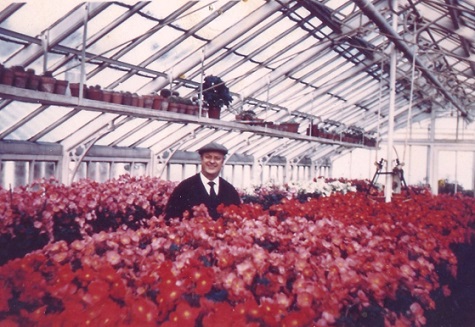
Which individuals have inspired you or helped you develop professionally?
Too many to mention them all! I have worked with many inspirational colleagues and every day has been a school day! The excellent tutors at South Manchester College set me off on my career path, with Dave Brayshay being ‘The Master’ who guided me and many students to success in the RHS exams. Harry Anderton, the expert Senior Propagator at Wythenshawe Park and Derek Myers, a war-veteran, disabled at Dunkirk, and champion grower of show hydrangeas, were both early mentors and inspirations.
When I came into parks management, Alan Barber was the great parks campaigner who inspired me and a generation of ‘parkies’, along with Ken Warpole and Liz Greenhalgh et al with their timely Parklife Report.
Reading the work of the great biologist Edward O Wilson, who coined the term biodiversity, first made me aware of the ‘biophilia effect’ and the health-enhancing effect of nature and green spaces which has led to the health and green space agenda promoted by many services.
In the subject of design and planting green spaces, Piet Oudolf, Noel Kingsbury, Nigel Dunnet and James Hitchmough have set the benchmark for a legion of practitioners in ‘naturalistic planting’, and more recently Dave Goulson has drawn the attention of parks managers to the current ‘sixth extinction’ of wildlife, and our role in protecting biodiversity.
And it was Laurence Gale who first persuaded me to write articles, which helped me clarify my thoughts on various aspects of the industry, and then build up a website, www.theparkkeeper.com, although it is now somewhat neglected as I seem to find little time these days to write for fun in these busy times!
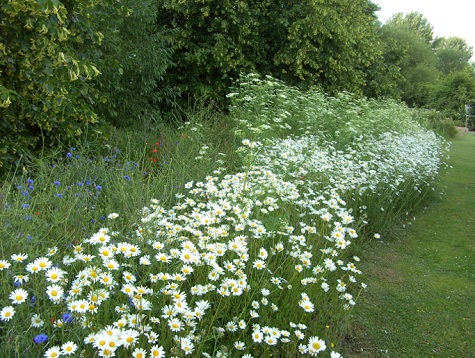
What machinery or innovations have in your opinion helped drive our industry forward or helped make your job easier?
Where to start with this question?!
- ICT development - smartphones and tablets for mobile working, social media, CCTV to monitor anti-social behaviour, GIS for mapping, management software for grounds and tree maintenance for starters.
- Sports pitches -parks have been transformed with modern equipment and drainage systems. The weekend goalmouth mud-baths have not gone completely, but where primary drainage with secondary sand-banding is properly installed, the carrying capacity of parks pitches have been hugely improved. Couple this with verti-draining, air injection and linear decompaction equipment such as Immants Shockwave and playing surfaces remain playable where previously cancellations were commonplace. Will Desso-type pitches ever be affordable in parks?
- Wildflower regimes - probably the most recent impressive leap forward in parks management has followed the development of wildflower seed supplies which allowed the change to long grass, wildflower meadow and naturalistic planting regimes, as thoughtful parks managers attempt to mitigate the impact of the ‘sixth extinction’ on biodiversity with wildlife-friendly designs. Sadly, the equipment required for cutting and clearing long grass, which is vital for their success, is still underdeveloped in the industry.
What concerns do you have for the future of our industry?
How much space do I have?!
- The role of parks and open spaces as natural capital and their contribution to ecosystem services, especially for biodiversity and nature recovery is still only marginally recognised, even by parks professionals.
- The contribution that local green spaces make to healthy lifestyles and physical and mental wellbeing is equally undervalued; even after the evidence of their crucially important role during the pandemic, the Government has ignored parks in its spending plans. Why are parks so invisible on the national agenda?
- Another concern is that housing, transport and building development, after swallowing great tracts of land, usually leaves behind an aftermath of fragmented parcels of damaged land as public open space with cheap planting, ruined habitats, budget play equipment and inferior infrastructure which Council’s, or more awkwardly, management companies are left to cope with.
How do you think we can entice the next generation of industry professionals to come and work in this industry?
I believe there will always be young people who love practical outdoor work, so we need to ensure there is high-quality training to ensure professional standards are upheld and we should provide structured career paths to ensure they are retained within the sector. We can also attract young people by building on their interest in nature and plants and their real concern for current issues such as protecting the environment, tackling global overheating and combatting the ecological carnage we are inflicting on habitats and species. The future parks sector should allow them to make a real difference.
Similarly, promoting the therapeutic value of green spaces and nature for healthy lifestyles and physical and mental wellbeing will register with many young people, and there will always be the attraction of outdoor sports and activities in the green space sector. Using social media and emerging ICT, such as augmented reality, is a good entry route, but young people need to be involved in parks management, encouraged to be part of planning, and be able to progress their ideas if they are to flourish in the sector.
Parks management has been going for well over a century, yet for some reason has never organised itself into an established coherent profession with career structures and a professional body. As a result, senior parks managers are becoming extinct, with management and maintenance often separated, and parks services morphed into Streetscene or ‘Cleaner, Greener’ departments. The hyper-functional complexity of open spaces management is being dumbed-down to cleaning and maintenance contract management while the sector has been a soft target area for cuts and ignorant interventionists. At long last, with the emergence of the Parks Management Forum, there is a glimmer of hope that ‘parkies’ may organise themselves into a professional body and move forward as the authoritative voice for the sector.
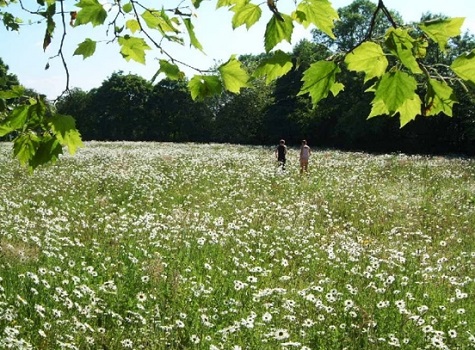
How have recent events impacted on your job and how would you like to see the government support our industry?
The fast-tracking of Covid risk assessments, constant putting up and removal of signage according to the changing guidance, the tearing down of signage and hazard tape, and poor behaviour by the public, the wear and tear due to greater use of paths and grassed areas etc have been the hallmarks of parks in the time of Covid-19. Many, including me, have been home-working with occasional site visits, but even these were stopped by the year-end. It has been far from ideal, with much work on hold, but it has allowed us to focus on some priorities and catch up with documentation! Where I currently work, the service is fortunately not too reliant on generated income.
There are many ways the government can support the industry, but I am not holding my breath! There will perhaps be some benefits from the Environment Bill and subsequent legislation, particularly on nature recovery, but generally parks will remain invisible, underfunded and underachieving until there is recognition through a national body that is close to government. Cabespace was only culled around ten years ago so I suspect there will be no great rush to resurrect anything similar, and if the vital role of green space during the pandemic didn’t signal a need for investment and support from a government that has spent so extravagantly elsewhere then parks and open spaces will continue to remain a Cinderella service. That is why we need to support and join the Parks Management Forum while we can!
 |
|
|
|